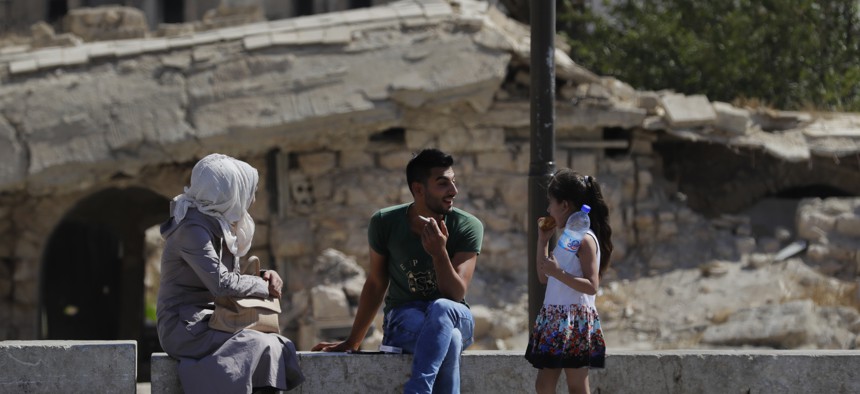
In this photo taken on Thursday, Aug. 16, 2018, Syrians sit in the square in the city of Aleppo, Syria. AP Photo/Sergei Grits
The US Will Spend Billions in Syria—Just Not on Rebuilding It
The Trump administration has ended a civilian aid program in the country, but the cost of the counter-ISIS fight far outweighs those savings.
When President Trump said on Twitter this weekend that the U.S. had ended “the ridiculous” $230 million in civilian funds it provides for Syria, he seemed keen to emphasize the savings to the U.S. He did not add that the U.S. will continue spending billions of dollars in the country to fight ISIS.
The stabilization funds—for projects like irrigation and demining—could have helped the U.S. preserve an element of its influence in the high-stakes diplomatic game being played out in Syria. Russia, Iran, and the Kurds are battling to maintain their gains in the country; Turkey is working to ensure the Kurds lose theirs; and Israel, Saudi Arabia, and the United Arab Emirates are invested to ensure Iran doesn’t emerge dominant in yet another Arab state. Russia, for example, is reportedly stepping up its aid and reconstruction efforts now that its ally Assad has regained control over much of the country.
And it’s Assad’s near-victory that makes U.S. involvement in civilian reconstruction a fraught proposition—implying as it does American support on de facto behalf of a regime the U.S. has twice bombed for using chemical weapons against civilians. Announcing the withdrawal of aid on Friday, the State Department spokeswoman emphasized that its mission in Syria was counterterrorism, not reconstruction, and that the Saudis would pick up the funding slack. In a conference call with reporters on Friday, State officials said the amount of U.S. funding withdrawn had already been offset by $300 million in contributions from U.S. allies, including Saudi Arabia. Heather Nauert, the State Department spokeswoman, said on the call: “The entire the reason that the United States is involved in Syria is … for the defeat of ISIS.” (The U.S. is still providing humanitarian assistance to Syria, with nearly $8 billion spent since the conflict started in 2011.)
ISIS, which at the height of its powers in 2014 controlled a significant area in the region that straddles Syria and Iraq, has now been pushed out of about 99 percent of the territory it held, according to Brett McGurk, the special presidential envoy for the global coalition to counter the Islamic State. Yet fighting them remains significantly more expensive than the just-ended civilian aid program—the Pentagon is set to receive $15.3 billion in fiscal year 2019, which begins October 1, for the purpose. That figure is a slight increase from the amount of money spent this fiscal year, $13 billion. But as Anthony Cordesman, a defense expert at the Center for Strategic and International Studies, noted, the increase is “almost solely because of the expanding effort to create more effective forces in Iraq.” The U.S. has about 2,000 troops in Syria, who train, advice, and assist forces that fight ISIS; another 3,765 U.S. troops remain in Iraq serving the same purpose.
While ISIS might have been pushed out of nearly all of the areas it controls in Syria, it is Assad’s forces, backed by Russia, Iran, and Hezbollah, that haveretaken much of that territory, as well as many of the areas once controlled by anti-Assad rebel forces—and nearly all of the country’s population centers. The areas Assad’s forces haven’t retaken, such as rebel-controlled Idlib province in the northwest, are firmly in Assad’s crosshairs.
By withdrawing the civilian funds, the Trump administration will likely help delay the return of millions of Syrians displaced by the conflict. The overwhelming majority of those displaced live in Turkey, Lebanon, and Jordan. More than a million have also made their way to Europe. The U.S. has resettled about 20,000 Syrians since the conflict began in 2011, including 56 in 2017 as of July 31. In Moscow, Sergey Lavrov, the Russian foreign minister, accused the U.S. of “trying to artificially slow down the process of the refugees’ return by refusing to participate in the restoration of infrastructure in Syria.”
As Syria starts shifting from conflict to reconstruction, a process that is expected ultimately to cost hundreds of billions of dollars, the U.S. says it won’t support international funding unless the UN unequivocally says there is progress in the political process in Syria. “We have been very clear, as clear as it is possible to be, with the government of Russia that there will be no international reconstruction assistance for Syria without the irreversible political process validated by the UN,” David Satterfield, who is the top U.S. diplomat for the region, said in the same conference call with Nauert. “There should be no ambiguity about that.”
Nor should there be any ambiguity about the fact that the U.S. military will remain in the region for some time. McGurk said on the Friday call that the U.S. is preparing the final phase of its plans to defeat ISIS.
“That will be a very significant military operation, because we have a significant number of ISIS fighters holed up in a final area of the Middle Euphrates Valley,” he said. “And after that, you have to train local forces to hold the ground to make sure that the area remains stabilized so ISIS cannot return. So this mission is ongoing and is not over.”



